
Upgrading California’s distribution grid to serve millions of electric vehicles could cost far less than the $50 billion that a study published last month indicated, the California Public Utilities Commission’s Public Advocates Office said in a paper announcing its own study.
“The Public Advocates Office is finalizing a study of the costs of upgrading the distribution grids of the three largest investor-owned utilities to meet California’s transportation electrification goals,” the paper said. “Our preliminary results indicate that the total cost of upgrading the distribution grid by 2035 will be approximately $15 billion to $20 billion.”
California law requires that all new vehicles sold in-state be zero-emitting by 2035, but the potential effects on the grid are only now being weighed.
A separate study commissioned by the CPUC and published May 9 found that it could cost as much as $50 billion to upgrade the distribution grids of Pacific Gas and Electric, Southern California Edison, and San Diego Gas & Electric to accommodate high levels of EV charging. (See Study: Calif. Needs $50B in Distribution Work for EVs.)
Energy analytics firm Kevala conducted the study. It emphasized that the findings assumed existing time-of-use rates would remain in place throughout the study period, from 2025 to 2035.
“It did not consider alternatives or future potential mitigation strategies such as alternative time-variant rates or dynamic rates and flexible load management strategies,” the firm said.
Kevala’s study predicted that distribution systems’ peak load would increase by an average of 56% from 2025 to 2035, requiring the utilities to nearly double their current spending on feeder lines, transformer banks and substations.
The Public Advocates Office, also known as Cal Advocates, is an independent consumer watchdog that often disagrees with CPUC staff and commissioners. It said it used assumptions different from Kevala in preparing its preliminary findings.
“The difference between our preliminary cost estimate and Kevala’s higher cost estimate stems from Kevala’s forecast of a larger growth in peak load,” it said. “Our peak load forecast is drawn from, and aligned with, the California Energy Commission’s Integrated Energy Policy Report (IEPR).”
Kevala’s peak load estimate may have resulted from its assumption that many EVs will be charged at 9 p.m., when time-of-use rates fall on weekdays.
In contrast, “the IEPR, which Cal Advocates uses, forecasts that EV charging occurs much more evenly across the day,” the paper said. “As peak load is a key driver of the need to upgrade the distribution grid, Kevala’s higher peak load growth forecast drives Kevala’s higher costs.”
The paper also says that that Kevala forecast the “total energy consumed in charging EVs will be 40% higher on the peak day than in the IEPR or in Cal Advocates’ study. Higher charging energy contributes to the difference in the peak loads and results in higher cost estimates.”
The advocates office said it intends to refine its analysis, engage with stakeholders and complete its study by August.
A second part of Kevala’s Electrification Impacts Study will build on the first part’s findings, including by developing scenarios that reflect state policy goals, state agency targets and the Energy Commission’s demand forecast. The advocates’ finding will be available to Kevala as it performs the second part, the office said.
Cal Advocates said additional studies would be useful for state planners.
“No single study or pair of studies, particularly this early in the electrification process, can definitively answer such a complex question as what the costs of distribution grid upgrades will be,” the office said. “Cal Advocates’ study aids the continuous discourse on electrification costs and benefits rather than establishing a final cost projection.”


